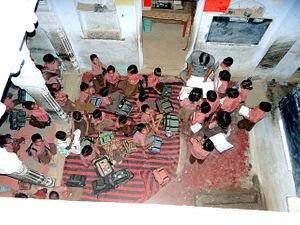India’s fabled young demographics were meant to put the country on the path to power and prosperity in the decades ahead. But some shocking new data shows that COVID-19 has thrown a huge wrench in the works.
According to the latest report on the State of India’s Environment, released by the Centre for Science and Environment, India is all set to usher in a “pandemic generation” that is likely to suffer far beyond the pandemic itself. A whopping 375 million children may suffer long-lasting impacts due to the pandemic, the report said, including being underweight, suffering stunted growth, and copping losses in education and economic productivity. And while over 500 million children were forced out of school worldwide due to COVID-19, the report said that India accounted for more than half of that number.
A large part of these losses has been caused by the gaps in India’s social safety system and the vast inequality in access to infrastructure across the country.
Take education. Over the past several years, India had managed to rapidly increase school enrollment rates owing to a slew of measures. Initiatives such as the midday meal scheme – which provided lunch to children in schools – created incentives for low-income parents to send their children to school rather than to work.
But with the emergence of COVID-19, many of these initiatives broke down, thereby undoing years of progress. As migrant workers began trudging back to their villages during the nationwide lockdown last year, their children too found their schooling discontinued – both due to the need to relocate as well as the need to work and compensate for their family’s lost income.
Even for those who continued to be enrolled in schools, education was difficult to obtain. The shift to online classes threw open the vast digital divide between the rich and poor in India and created massive inequality in access to education. According to some estimates, only 24 percent of Indian families and a mere 38 percent of Indian schoolchildren have access to the internet. But while 42 percent of households in urban India can access the internet, only a paltry 15 percent in rural India can.
Inequalities have also been exacerbated on parameters of health. The shutting down of physical classes also meant that the midday meal scheme had to be discontinued – thereby depriving millions of children from low-income households of basic nutrition. Meanwhile, many children who were previously housed in residential schools now had to suddenly relocate with their families to unhealthier surroundings, owing to economic need. In the state of Odisha, for instance, hundreds of children of brick workers, who previously studied and lived in residential schools, were now forced to live with their families in brick kilns after those schools shut down.
Even as India ramps up its vaccination program, many of these challenges appear unlikely to go away soon. Owing to the economic slowdown caused by COVID-19, many of India’s low-budget private schools – which cater to the poor and are widely seen by them as better alternatives to the public school system – are suffering from financial troubles. In Karnataka alone, about 500 schools were reported to be closing down for good by October last year.
The gaps in India’s social infrastructure have not been helped by the government’s crackdown on various international NGOs and charity organizations, which have been building gains across the country for decades. Indian charities receive over $2 billion a year in foreign donations, driving efforts against malnutrition, illiteracy, and child mortality. Yet, many of these organizations have been vilified in recent times by Hindu nationalist politicians who claim that they are involved in “anti-national activities.” In the middle of the pandemic last year, the Modi government passed laws that restricted avenues for foreign funding to NGOs, thereby starving many of them of crucial resources.
The impacts of the pandemic on India’s youth threaten to last for years to come, undoing decades of progress on multiple fronts. India’s post-COVID-19 recovery plans must necessarily include efforts to build critical social infrastructure. That would require a massive collaborative effort between the government, the private sector and various non-governmental organizations. India’s future growth will depend on it.

































